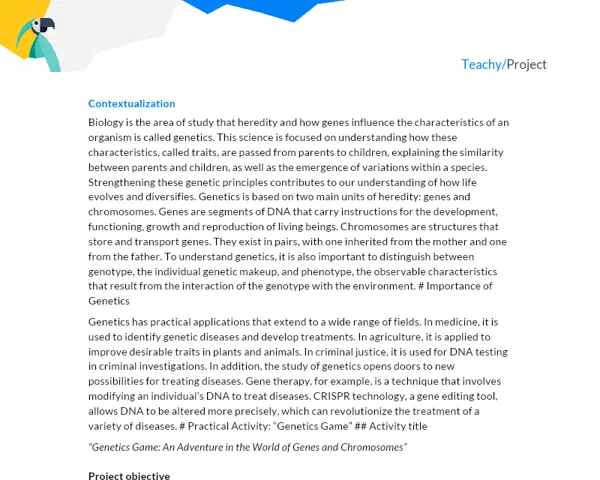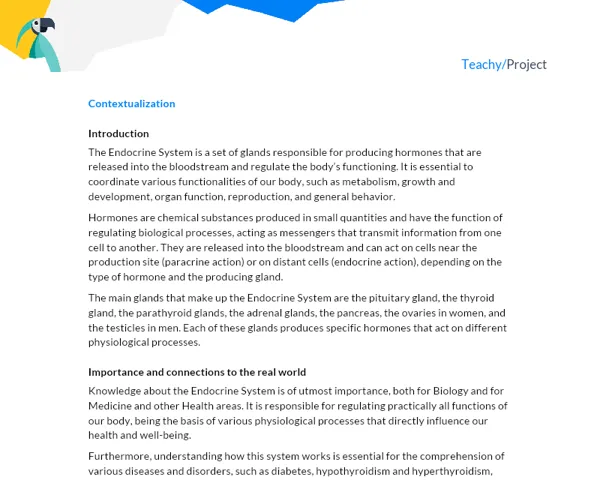Putting into Context
Theoretical Introduction
Bacteria are unicellular microorganisms, prokaryotes, meaning they don't have a defined nucleus, which can be found practically everywhere. They are extremely resistant organisms, able to survive in extreme conditions, such as high temperatures and high salinity. There is a great diversity of bacteria, many of which are essential for human beings, since they are involved in processes such as food digestion and protection against pathogenic agents.
Although many bacteria are harmless and even beneficial, there is a group of pathogenic bacteria that cause diseases in humans and other living beings. When these bacteria enter our bodies, they can cause infections, such as tuberculosis, leptospirosis, cholera, among others. It is important to emphasize that the study of bacteria is fundamental to understanding various diseases and for developing treatments.
In addition, bacteria play a crucial role in the environment, since they participate in the recycling of nutrients in nature, by decomposing organic matter and transforming it into nutrients, which will be reused by other species. They are also fundamental in the nitrogen cycle, one of the main nutrients for plants.
About the Theme and Its Importance
Understanding the role of bacteria and their influence on the world is fundamental for understanding our own health and the environment. From the food industry, where they are used in the production of yogurts and cheeses, to the environment, where they help to break down waste, bacteria are everywhere and play essential roles.
In addition, by becoming more familiar with pathogenic bacteria, we can understand how some diseases occur and work on preventing and treating them. Another important point is to study bacteria resistant to antibiotics, a growing problem in modern medicine. Therefore, this project is an opportunity to learn more about these organisms that are so small, yet of such great importance to life on Earth and to our society.
Practical Activity
Title of Activity: The Hidden World of Bacteria
Project Goal
The objective of this project is to investigate the diversity of bacteria, understand their importance in the environment and human health, and recognize the challenges related to bacterial resistance to antibiotics.
Detailed Project Description
Students will be divided into groups of 3 to 5, and together they will investigate the key concepts related to bacteria. The project themes include: the diversity of bacteria, the ecological functions of bacteria, pathogenic bacteria, and bacterial resistance to antibiotics.
The activity will be carried out in an interdisciplinary manner, mainly involving the discipline of Biology, in which students will study the general characteristics of bacteria, their diversity, and diseases caused by them, as well as the discipline of Chemistry, where they will learn about the functioning of antibiotics and the mechanisms that lead to bacterial resistance.
The project is expected to last more than twelve hours per student and will be implemented over approximately three weeks.
Required Materials
- Computer with internet access
- Textbooks and online materials on bacteria
- Writing materials (pens, pencils, paper, etc.)
Detailed Step-by-Step
-
Theoretical Research: Students should begin by researching the four main topics of this project. Each group will be responsible for a specific sub-theme, in order to cover the four sub-themes among the different groups in the class.
-
Case Study: Once this is done, each group must research and select a case study relevant to the sub-theme for which they are responsible. For example, a group responsible for the sub-theme "Pathogenic Bacteria" could choose "Tuberculosis" as a case study.
-
Infographic Development: Based on the theoretical research and the case study, each group must develop an infographic that illustrates their main findings.
-
Panel Discussion Simulation: Each group will present their infographic to the class as if they were at a discussion panel at a scientific conference, explaining what they learned and answering questions from other students.
-
Written Document: After the presentation, each group should write a detailed report of at least 10 pages, following the established structure (Introduction, Development, Conclusions, Bibliography).
Project Deliverables
At the end of the project, each group must deliver:
-
Infographic: This should be clear, informative, and visually appealing. It should present the main points of the sub-theme and the case study.
-
Written Document: The report must contain at least 10 pages, including the following structure:
- Introduction: This should provide context for the sub-theme, its relevance and application in the real world, and the objective of this project.
- Development: This should explain the theory behind the sub-theme, explain the case study in detail, indicate the methodology used, and finally present and discuss the results obtained.
- Conclusion: This should restate the main points, explaining the learning achieved and the conclusions drawn about the project.
- Bibliography: This should indicate the sources used to work on the project, such as books, web pages, videos, etc.
The project thus seeks to build solid knowledge through a collaborative and engaging approach on a highly relevant topic in biology and public health.


